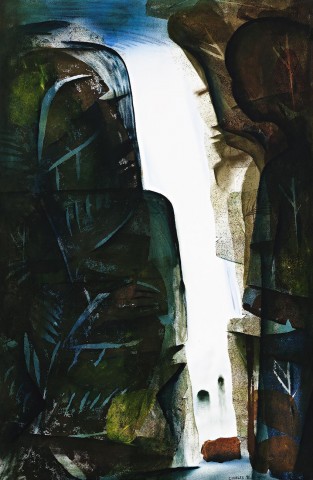RAINFOREST: GUARDIAN OF THE FALLS I, 1984
CHARLES BLACKMAN
oil on paper on board
174.5 x 114.5 cm
signed lower right: CHARLES BLACKMAN
The Christensen Fund, Perth
Christie’s, Melbourne, 29 April 1996, lot 107
Art Galleries Schubert, Queensland
Private collection, United Kingdom, acquired from the above, c.2000
Alvarez, A., Rainforest: Charles Blackman, Macmillan, Melbourne, 1988, cat. CC6164, no. 15, pp. 37 (illus.), 108
The sunshine state of Queensland provided Charles Blackman with a haven and a much-needed connection to the natural world. Having been nurtured throughout his long career by connections with Queenslanders, particularly Marjorie and Brian Johnstone of the Johnstone Gallery, the painter Jon Molvig and the modernist architect James Birrell, the influence of Queensland on his artworks was such that in 2015, an exhibition was staged at the Queensland Art Gallery under the title Lure of The Sun. And a lure it certainly was - ‘Brisbane beckoned us … painter mates in the city … and poet friends on their mountain’, wrote Barbara Blackman in her memoirs.1 Blackman’s rekindling of a friendship with Birrell in Maroochydore in 1979 provided the impetus for his relocation to Buderim in the early 1980s: ‘I loved the area and its climate and I loved meeting my friend James, who lived in an old wooden house right by the Maroochy River’, the artist wrote in 1988.2
The magical and atmospheric paintings that would flow from this new environment were created in a sustained burst of activity, and all described the ‘the lightness of [Queensland’s] colour and its friendly spirit’.3 Chief amongst them is Rainforest: Guardian of the Falls I, 1984. Painting the waterfall behind his new home, Blackman imagined the watery source of the ‘living museums’ of its surrounding ancient rainforests, in its ideal state, ‘how it used to be’4. His inspiration thence drawn away from brooding psychodramas, Blackman painted the dense earthly pleasures of his new verdant landscape.
A page in his Buderim Mt Sketchbook: Civilization versus Eden, 1984, in the collection of the Queensland Art Gallery / Gallery of Modern Art Research Library, includes a preparatory sketch for this painting, and others within the Waterfall series. A sketch titled, Waterfall descending a Staircase, makes reference to Marcel Duchamp’s famous painting of 1912, Nude Descending a Staircase in the collection of the Philadelphia Museum of Art. Blackman, in seeing clearly the architectural qualities of the rainforest (other paintings bore titles such as Cathedral, Staircase, Buttress, Door and Citadel), sought to incorporate a Cubist approach to painting organic movement. The mossy rocks surrounding this waterfall are fragmented and fractured. In the absence of bright sunlight, the gleaming white waterfall could well be illuminated by the light of the moon, its brilliant power presented as a pure, coursing body of water whose blue ripples remain trapped at the top of the chute. The dark density of the unknowable rainforest is presented here as a mythical entity, personified into a schematic and peaceful face, the guardian spirit partially obscured in the glassy rocks borne of the volcanic soil of Mount Buderim.
1. Blackman, B., Glass After Glass: Autobiographical Reflections, Viking, Penguin Books Australia, Victoria, 1997, p. 230
2. Blackman, C., and Alvarez, A., Rainforest, The Christensen Fund, MacMillan, Melbourne, 1988, p. 4
3. The artist, 1965, quoted in Hawker, M., Lure of the Sun: Charles Blackman in Queensland, Queensland Art Gallery, Brisbane, 2015, p. 16 op. cit., p. 6
4. The artist, 1987, quoted in Blackman, C., and Alvarez, A., op cit, p. 6
LUCIE REEVES-SMITH
